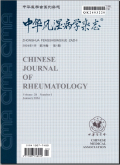吗替麦考酚酯在对熊去氧胆酸应答不佳的原发性胆汁性胆管炎患者中的应用
Combination therapy of mycophenolate mofetil and ursodeoxycholic acid for the treatment of patients with incomplete response to ursodeoxycholic acid in primary biliary cirrhosis
摘要目的:观察熊去氧胆酸(UDCA)联合吗替麦考酚酯(MMF)治疗UDCA应答不佳的原发性胆汁性胆管炎(PBC)患者的疗效。方法:研究对象为北京协和医院根据巴塞罗那标准UDCA应答不佳的PBC患者,干预方式为MMF(0.75~1.5 g/d)联合UDCA(13~15 mg·kg -1·d -1)治疗,观察期为至少12个月。检测比较治疗前后各时间点血清ALT、AST、ALP、γ-谷氨酰转肽酶(GGT)、白蛋白(Alb)、总胆红素(TBil)、免疫球蛋白(Ig)M、IgG、IgA水平,参照既往报道的巴塞罗那标准7个应答标准评价生化应答率。治疗后与基线指标的比较符合正态分布采用配对 t检验,不符合正态分布则采用非参数Wilcoxon秩和检验。2组独立样本分析不符合正态分布采用Mann-Whitney U检验。 结果:共纳入29例PBC患者,最终有17例患者联合治疗满12个月。治疗后3个月血清ALP较基线显著下降[(369±184) U/L和(309±148) U/L, t=2.149, P=0.045],3个月后该统计学差异消失。治疗6个月后GGT下降差异具有统计学意义[266.5(205.5,414.0) U/L和217.5(173.8,391.8) U/L, Z=-2.334, P=0.018],且持续至用药后12个月。免疫球蛋白IgM、IgG和IgA在联合治疗3个月、6个月及12个月时差异均有统计学意义。AST、TBil、白蛋白差异均无统计学意义。各应答标准评估疗效,应答率在9.5%~23.5%。 结论:UDCA联合MMF治疗UDCA应答不佳的患者疗效欠佳,这可能与联合治疗干预时机有关。早期识别UDCA应答不佳的患者,用更高质量的研究验证联合治疗方案具有重要意义。
更多相关知识
abstractsObjective:To observe the efficacy of mycophenolate mofetil (MMF) combined with ursodeoxycholic acid (UDCA) for the treatment of primary biliary cholangitis (PBC) with incomplete response to UDCA monotherapy.Methods:This is an open label study. Combination therapy of MMF (0.75-1.5 g/d) and UDCA (13-15 mg·kg -1·d -1) were applied to PBC patients with incomplete response to UDCA alone according to Barcelona Criteria. The expected observation duration of treatment were at least 12 months. The levels of serum alanine amiotransferase (ALT), aspartate transaminase (AST), total bilirubin (TBil), albumin (Alb), alkaline phosphatase (ALP), γ-glutamyltranspeptidase (GGT), immunoglobulin (Ig)M, IgG, IgA were mea-sured at different time points before and after treatment. The biochemical response rates were evaluated with reference to formerly reported criteria including Barcelona criteria and so on. Paired student's t-test and wilcoxon matched-pairs signed rank test were used to compare differences between groups before and after treatment. Mann-Whitney U test was used to compare differences between the two independent groups with abnormal distribution. A two-sided P<0.05 was considered statistically significant. Results:Seventeen of 29 patients included were treated with combination therapy for at least 1 year. The levels of serum ALP were significantly decreased after 3 months [(369±184) U/L vs (309±148) U/L, t=2.149, P=0.045] but not afterwards. GGT levels were significantly decreased at 6 months [266.5(205.5, 414.0) U/L vs 217.5(173.8, 391.8) U/L, Z=-2.334, P=0.018] and the significance continued to 1 year. IgM, IgG and IgA levels had a significant decrease at 3, 6 and 12 months but not AST, Tbil or Alb levels. The biochemical response rates were between 9.5%-23.5%. Conclusion:Overall, the biochemical response rate of combination therapy of MMF and UDCA is low in incomplete responders to UDCA alone. Early recognition of incomplete responders is of great im-portance and high quality researches are needed to confirm the effectiveness of the combined therapies.
More相关知识
- 浏览0
- 被引1
- 下载0


相似文献
- 中文期刊
- 外文期刊
- 学位论文
- 会议论文



 换一批
换一批 换一批
换一批



